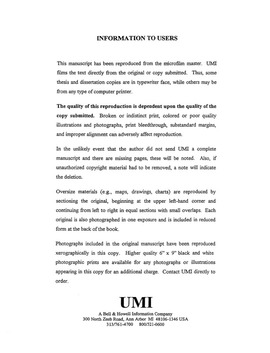| dc.contributor.advisor | Nussbaum, Jon, | en_US |
| dc.contributor.author | Crowell, Tara Lynn. | en_US |
| dc.date.accessioned | 2013-08-16T12:30:30Z | |
| dc.date.available | 2013-08-16T12:30:30Z | |
| dc.date.issued | 1999 | en_US |
| dc.identifier.uri | https://hdl.handle.net/11244/5803 | |
| dc.description.abstract | Results of this study indicate that prior to infection, HIV positive heterosexuals reported having similar safer sexual beliefs, attitudes, communication, and behaviors to those not infected with virus. Specifically, participants reported moderate levels of knowledge regarding HIV, and low levels of condom use when engaging in oral, vaginal, and anal sex. These results are consistent with past research on HIV negative individuals' safer sex knowledge and behavior. Thus, this study reveals no real differences between HIV positive and HIV negative individuals' awareness of the virus or condom usage. | en_US |
| dc.description.abstract | High levels of personalization of HIV were found neither in this sample nor in other research focusing on HIV negative individuals. The absence of personalization provides one possible explanation for many of the above findings-high knowledge and skill levels, but low levels of safer sex communication and behavior due to the low levels of perceived risk of infection. Without personalization of the risk of HIV, individuals are not motivated to convert their beliefs and skills into corresponding behaviors (safer sex communication and condom use). (Abstract shortened by UMI.) | en_US |
| dc.description.abstract | Findings of gender differences and differences in relational status are also important. Specifically, men reported higher levels of condom-self-efficacy, and argumentativeness; whereas women perceived their partners as "safer" than did men. Additionally, those in serious relationships perceived their partners as safer than those in casual relationships. | en_US |
| dc.description.abstract | Forty HIV positive heterosexuals, who were infected through heterosexual sexual activity, completed an on-line questionnaire. Each participant provided information on their perceived HIV knowledge, perceived risk of HIV, safer sex communication, and safer sex behavior prior to infection. Participants' responses to closed and open ended questions were analyzed to identify the characteristic of heterosexuals living with HIV and determine if HIV positive and HIV negative individuals hold similar levels of safer sex knowledge, attitudes, communication, and behavior. Additionally, participants based on their experience living with HIV, provided suggestions and/or advice to HIV negative individuals. | en_US |
| dc.description.abstract | Participants in this study reported high levels of willingness to engage in safer sex communication, but low levels of actual communication. Further, results revealed that participants who engaged more often in safer sex communication were more likely to use condoms. In this study the positive relationship between communication and condom use is similar to results from past research findings. Additionally, participants reported high levels of condom self-efficacy and moderate levels of assertiveness; both variables positively correlated with condom use. Again, these results parallel past findings and illustrate similarities between the two groups. Finally, participants reported that they believed they did not need to discuss using condoms because they were not at risk. Previous research reveals that HIV negative individuals' reported holding the same beliefs. | en_US |
| dc.description.abstract | Another similarity revealed between HIV positive and HIV negative individuals was their attitudes toward HIV and safer sex behaviors. Results indicate that prior to infection, HIV positive individuals had moderate to high levels of trust for their partners, low levels of perceived risk of infection, and high levels of perceived partner safety. Additionally, this study found a negative relationship among participants' level of vulnerability, perceived partner safety, and partner trust. Participants' perception of partner safety combined with partner trust explained 40% of their perceived level of risk. Past research on HIV negative individuals yields similar findings of the relationship between individuals perceived invulnerability, trust, and perceived safety of partner. | en_US |
| dc.format.extent | xvii, 245 leaves : | en_US |
| dc.subject | Health Sciences, Public Health. | en_US |
| dc.subject | Speech Communication. | en_US |
| dc.subject | Psychology, Social. | en_US |
| dc.subject | AIDS (Disease) Prevention. | en_US |
| dc.subject | Education, Health. | en_US |
| dc.title | Personalizing the risk of AIDS: Investigating the attitudes, communication and behavior of people living with HIV. | en_US |
| dc.type | Thesis | en_US |
| dc.thesis.degree | Ph.D. | en_US |
| dc.thesis.degreeDiscipline | Department of Communication | en_US |
| dc.note | Source: Dissertation Abstracts International, Volume: 60-05, Section: A, page: 1395. | en_US |
| dc.note | Adviser: Jon Nussbaum. | en_US |
| ou.identifier | (UMI)AAI9929556 | en_US |
| ou.group | College of Arts and Sciences::Department of Communication | |
